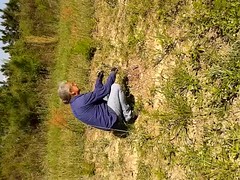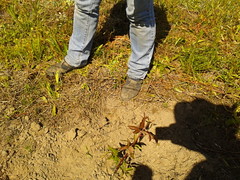Where those rusted nuts used to be:
Attached:
Continue reading
 Fruit bushes and trees: blueberry, crabapple, fig, pomegranite, and olive.
Fruit bushes and trees: blueberry, crabapple, fig, pomegranite, and olive.
Sixteen blueberries: Continue reading
 Withlacoochee River raspberries,
found by the GA 122 bridge:
Withlacoochee River raspberries,
found by the GA 122 bridge:
Pictures of Gretchen Quarterman with Withlacoochee River raspberries by John S. Quarterman for Okra Paradise Farms, Lowndes County, Georgia, 23 April 2013.
-jsq
Pictures by John S. Quarterman for Okra Paradise Farms, Lowndes County, Georgia, 23 April 2013.
-jsq
On May 25, activists around the world will unite to March Against
Monsanto.
 In Savannah, OccupyMonsanto says:
In Savannah, OccupyMonsanto says:
2pm at the Fountain in Forsyth Park at noon, with photo ops, educational tables, music and more — join us and send a powerful message to one of the most polluting corporations in the world!Oher Georgia events include Athens, Brunswick, and Atlanta.
Here’s
how to organize a march.
Why?
 David Knowles wrote for New York Daily News 8 May 2013,
VIDEO: Stars align in protest against food giant Monsanto over GMO crops:
Foes of the conglomerate have produced a video shining light on the supposed dangers of genetically modified crops. Bill Maher, Danny Devito and Dave Matthews will be among the celebrities speaking out.
David Knowles wrote for New York Daily News 8 May 2013,
VIDEO: Stars align in protest against food giant Monsanto over GMO crops:
Foes of the conglomerate have produced a video shining light on the supposed dangers of genetically modified crops. Bill Maher, Danny Devito and Dave Matthews will be among the celebrities speaking out.
The video: Continue reading“Here in America you don’t get the right to know whether you’re eating genetically modified organisms,” Dave Matthews says in the video that asks viewers to participate in a global day of protest against the company on May 25.
Monsanto is always hiding behind something, starving children (while selling their parents crops that fail all at once), the Great God Efficiency, or now, medical research. Will Clarence Thomas recuse himself this time on this Supreme Court seed patent, Bowman v Monsanto? Will Monsanto manufacture enough Fear, Uncertainty, and Doubt (FUD) to win anyway, or will the other SCOTUS judges rule wisely this time?
Andrew Pollack wrote for the New York Times 13 February 2013, Farmer’s Supreme Court Challenge Puts Monsanto Patents at Risk,
Monsanto says that a victory for Mr. Bowman would allow farmers to essentially save seeds from one year’s crop to plant the next year, eviscerating patent protection. In Mr. Bowman’s part of Indiana, it says, a single acre of soybeans can produce enough seeds to plant 26 acres the next year.
Such a ruling would “devastate innovation in biotechnology,” the company wrote in its brief. “Investors are unlikely to make such investments if they cannot prevent purchasers of living organisms containing their invention from using them to produce unlimited copies.”…
The decision might also apply to live vaccines, cell lines and DNA used for research or medical treatment, and some types of nanotechnology.
Yeah, yeah, it could. But it would be quite easy for SCOTUS to say this ruling is about seeds.
Many organizations have filed briefs in support of Monsanto’s position — universities worried about incentives for research, makers of laboratory instruments and some big farmer groups like the American Soybean Association, which say seed patents have spurred crop improvements. The Justice Department is also supporting Monsanto’s argument.
And the American Soybean Association represents big growers who plant Monsanto seeds. Too bad they don’t realize they’d make more profits if they didn’t have to pay for those seeds every year even when Monsanto jacks up the price ( 43% in 2009), plus pay for the expensive pesticides that go on them, and the expensive huge tractor equipment to farm at the scale Monsanto demands. Another group that should know better weighs in:
Continue reading
 This year’s
SoGa Growing Local & Sustainable Conference
was a satisfying success, and next year it moves to Lowndes County.
This year’s
SoGa Growing Local & Sustainable Conference
was a satisfying success, and next year it moves to Lowndes County.
Not only did 260 people sign up, but all the sessions were well-attended, and everybody seemed to learn something new, from hoop houses to solar power, from hands-on workshops to all-hands plenary sessions. Of course the food was excellent. You can get a hint from this picture of Janisse Ray opening the conference; the food in the foreground is on the snack tables (ah, the honeycomb!). Then there were the meals, potluck by and for a conference-full of foodies.
In 2011 about 50 people came to the first one in Tifton. In 2012, about 150 people went to Reidsville. In 2013, about 260 people signed up, also for Reidsville, Tattnall County, to learn what it takes to grow local sustainable food here below the gnat line in this longleaf pine land of tea-colored rivers, acid soil, and rich gardening traditions.
As Janisse Ray wrote on the facebook event for this year’s conference:

SoGa Growing Local 2014 will be held in Valdosta, GA. Gretchen Quarterman will be the lead organizer. We’ll be keeping you posted on the date so you can put it on your calendars now. (We may do a mini version in Tattnall in 2014.)
More later on what happened at this year’s conference, and more as it develops on next year’s conference. So far, many local farmers, civic and business organizations, and local governmental bodies have offered to help, and Gretchen is forming an organizational committee. Stay tuned!
-jsq
I think this is the third year of a fascinating conference that started when some people in south Georgia realized nobody else was going to talk about what it takes to grow local sustainable food here below the gnat line in this longleaf pine land of tea-colored rivers, acid soil, and rich gardening traditions. -jsq
Red Earth Farm Janisse Ray present:SoGa Growing Local & Sustainable Conference
A day-long, information-rich, action-packed, affordable conference designed to get you healthier and save you money.
When and Where:
9AM to 6PM, Jan. 26, 2013
Tattnall County High School,
Highway 23/57 South,
(1 Battle Creek Warrior Blvd)
Reidsville, GA 30453Registration:
PDF, Word
$30 before Jan. 15;
$45 afterwards.
Includes lunch.Many do-it-yourself workshops in homesteading and country living: mushroom culture, beekeeping, backyard chickens, soil-building, small fruit production, economics, gardening for wildlife, charcuterie, natural cleaning, fermentation, herbs on the menu, natural cleaning & body care products, making jams & jellies, vermiculture, weed management, marketing, everything you need to know about small farming. Ladies Homestead Gathering, seed-saving. And so much more….
Conference actually starts on Friday with a potluck, reading & a showing of the film “Grow.”
For more information see Registration on the left here, or email redearthfarm at yahoo.
Gretchen Quarterman will be giving a workshop at the Growing Local conference: Beginning lesson on home made jams and jellies. What you’ll need (not much) to start making delicious sweets from fruits that are easily available.
Inspirational gardener & naturalist Ellen Corrie of Tifton, Ga. will be teaching a workshop on Gardening for Wildlife at the Growing Local conference Jan. 26. This presentation will look at how gardening for wildlife makes your garden (whatever size) healthier and helps restore habitat and preserve biodiversity. There’ll be an overview of factors which need to be considered to attract and keep any wildlife or beneficial general. I’ll focus on pollinators and specific practices and plants to attract them. — with Leeann Drabenstott Culbreath and Dan Corrie.
Albert Kipple Culbreath will be teaching a Mushroom-Growing Workshop at the conference. Inoculation and care of logs for production of shiitake and oyster mushrooms. Will include information on where to obtain supplies, how to handle logs, which type logs to use, care for the logs, and culinary uses. Sign up now. — with Leeann Drabenstott Culbreath.